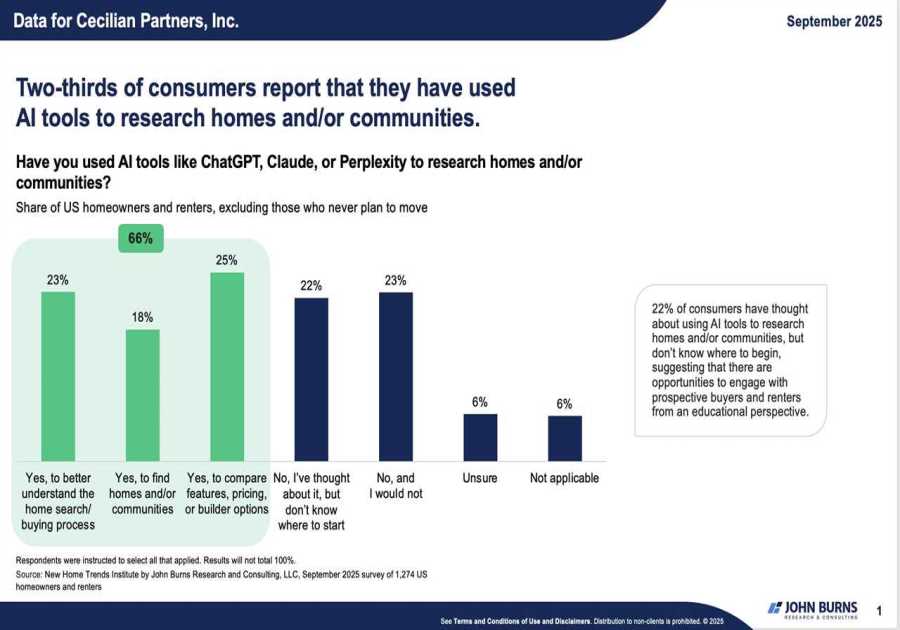Many would-be homebuyers are now lurkers. They browse. They dream. They stall. It’s not just economic uncertainty slowing them down; hesitation thrives when facts are hard to find and homework feels overwhelming.
Right now, your biggest competitor isn’t another builder. It’s indecision.
Meanwhile, the way buyers search has shifted. Many are asking systems to do the heavy lifting:
“Show me communities within 35 minutes of work, with a plan that fits a king bed and a home office, and tell me the real monthly number.”
If your digital presence can’t answer that level of intent with clarity and consistency, an AI summary—or a third-party site—will answer for you. Chances of accuracy? Maybe 50/50.
This is the moment of risk and opportunity. And it’s why builders should treat AI-era search as the new front door to their brand.
What the Data Signals
According to new survey questions Cecilian Partners developed in collaboration with the New Home Trends Institute (September 2025), 66% of move-intenders, 66% of move-intenders have used AI to research homes and communities, most often to understand the process, compare builders and options, and explore locations. Another 22% have considered using AI but don’t yet know where to start.
The same study found that while young families lead AI adoption, homeowners overall are more likely than renters to rely on it for search and comparison. This isn’t a Gen Z experiment; it’s becoming the default for serious shoppers and it will define the next generation of homebuyers.
A Realtor.com survey (October 2025) points the same way: 82% of Americans use AI for housing information. Real estate agents remain the most trusted source, but AI ranks second, ahead of friends, family, and social media as a way to “get smarter” about the market.
What it means: AI-enabled discovery paired with human-led commitment is fast becoming the default path from curiosity to confidence.
“Designing for your current buyer—that, to me, is the biggest risk,” says Russ Kliman, a board member at Cecilian Partners and founder & CEO of FutureCrafted. “You’ve got to be laying the groundwork for your future buyer. Because once they arrive, you don’t want that ‘oh sh*t’ moment.”
Four Moments That Matter: Where AI Changes the Buyer Journey
The sales funnel is no longer a straight line. Buyers now loop continuously through exploration, comparison, and validation, often guided by AI or social discovery and reinforced by human connection. Here’s where builders can win, or lose, the sale:
Discover: Turn vague intent into real options
Buyers want to dream, but they need help understanding the process. AI can uncover where buyers feel uncertain and give them a safe way to ask what they don’t know. Builder teams can also use AI to see the journey through a buyer’s eyes: “How would you explain this if I’d never bought a home before?” That exercise reveals where your current content falls short.
“Think about where consumers feel vulnerable in the homebuying experience, where they’re embarrassed to say ‘I don’t understand what that means,’” says Kliman. “How do you build trust? How do you create transparency?”
Consider: Compress the homework
AI tools can compress a week of research into a single summary, but only if your information is structured, current, and consistent. Treat Generative-Engine Optimization (GEO) as the evolution of SEO. Structure data like price, inclusions, taxes, and timelines so AI can surface it faithfully across platforms.
- McKinsey (October 2025) projects that AI summaries will appear in 75% of search results by 2028, and brands that don’t adapt could lose 20–50% of traditional search traffic.
Decide: Boost confidence to close
When your website, feeds, and sales materials contradict one another, buyers lose trust fast. Align your facts (what’s included, what it costs, etc.), and synchronize them across every channel, including onsite sales conversations. The clearer your information, the faster the “yes.”
Own: Post-contract clarity matters
The AI-plus-human loop doesn’t end at contract. Buyers will keep asking AI for updates on timelines, selections, and warranty details. Design your content so those answers are accessible without a click—and ensure your people echo the same truths in every interaction.
The Missing Advantage: Knowing What Buyers Need
Builders talk about meeting buyers where they are, but few actually know where that is. You can’t create AI-readable content or deliver human answers that build trust if you’re guessing what buyers ask.
The builders who win the next wave of sales will be those who use real-time customer and sales data to close that gap.
Every digital signal is a clue: which homes get the most map views, which floorplans spark repeat visits, which models get the most traffic. That behavioral data reveals what buyers are trying to decide, and what’s getting in their way. Layer in demographic and sales data, and those patterns sharpen into personas: who’s shopping and how they think about value.
Turn that intelligence into action:
● Convert top questions into on‑page answers using plain language.
● Build personas from traffic and sales data to tailor content and tone.
● Keep critical facts synced across sites, listings, signage, and sales tools.
Data doesn’t replace intuition; it validates it. It’s the feedback loop that helps builders anticipate questions before they’re asked, and turns digital impressions into confident next steps.
Where to Start
Here are five strategic pillars to help builders operationalize this approach:
1) Answer better, on every page.
Treat every community and plan page on your website as a canonical source of truth. If a buyer (or an AI agent) asks a reasonable question, the answer should live right there. Use plain language and consistent facts.
2) Make truth travel beyond your site.
Ensure the same numbers appear across all AI-readable channels, including your website, syndication feeds, and sales tools. This is where the unglamorous work of clean, structured data pays off.
3) Lead with people (and put them on the same page as digital).
When digital and human answers align, you stop losing buyers to confusion. Train sales teams echo the language and data from your site, so conversations pick up where digital left off.
4) Earn trust in the open.
The industry fear that revealing too much will reduce traffic is outdated. You can’t trick someone into buying a home that doesn’t meet their needs. Replace “Starting from…” with transparent, realistic pricing and timelines. In an AI-mediated search, transparency gets you shortlisted.
“In the near term, builders should focus on how AI is reshaping Google and other search tools—optimizing so they don’t fall by the wayside,” says Kliman. “Longer term, it’s about rethinking the entire value chain of awareness, engagement, and trust through the lens of AI.”
Get it Right Now
In a market where hesitation feels safer than action, clarity converts.
The data shows buyers already rely on AI to learn, compare, and self-educate. As more digital-native generations are searching for homes, that reliance will only deepen. Builders who become the most trusted answer will win the right to a human conversation and a faster close.
AI is rewriting the home search. The question is whether builders will let someone—or something—else tell their story first.
------------Read More
By: Jessica Kerrigan
Title: AI is rewriting the new home search. Here’s how homebuilders can win
Sourced From: www.housingwire.com/articles/ai-is-rewriting-the-new-home-search-heres-how-homebuilders-can-win/
Published Date: Fri, 14 Nov 2025 18:43:51 +0000
.png)





